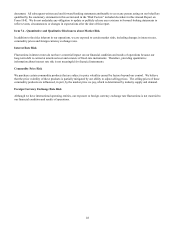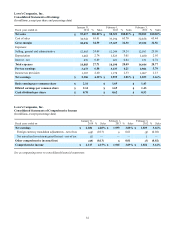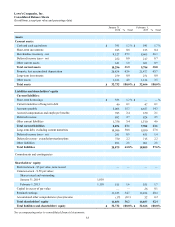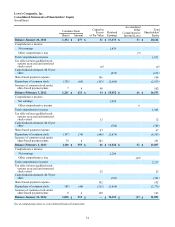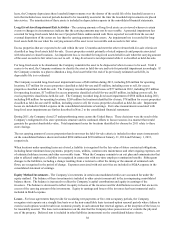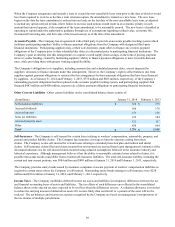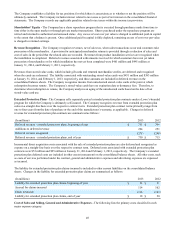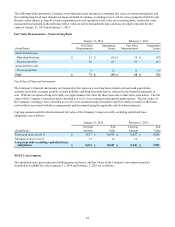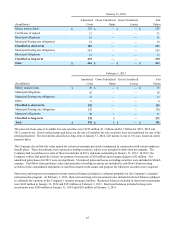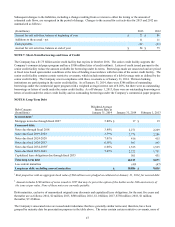Lowe's 2013 Annual Report Download - page 45
Download and view the complete annual report
Please find page 45 of the 2013 Lowe's annual report below. You can navigate through the pages in the report by either clicking on the pages listed below, or by using the keyword search tool below to find specific information within the annual report.37
treats these funds as a reduction in the cost of inventory as the amounts are accrued, and are recognized as a reduction of cost of
sales when the inventory is sold. Funds that are determined to be reimbursements of specific, incremental and identifiable costs
incurred to sell vendors’ products are recorded as an offset to the related expense. The Company develops accrual rates for
vendor funds based on the provisions of the agreements in place. Due to the complexity and diversity of the individual vendor
agreements, the Company performs analyses and reviews historical trends throughout the year and confirms actual amounts
with select vendors to ensure the amounts earned are appropriately recorded. Amounts accrued throughout the year could be
impacted if actual purchase volumes differ from projected annual purchase volumes, especially in the case of programs that
provide for increased funding when graduated purchase volumes are met.
Derivative Financial Instruments - The Company occasionally utilizes derivative financial instruments to manage certain
business risks. However, the amounts were not material to the Company’s consolidated financial statements in any of the years
presented. The Company does not use derivative financial instruments for trading purposes.
Credit Programs - The majority of the Company’s accounts receivable arises from sales of goods and services to commercial
business customers. The Company has an agreement with GE Capital Retail (GECR) under which GECR purchases at face
value commercial business accounts receivable originated by the Company and services these accounts. This agreement
expires in December 2016, unless terminated sooner by the parties. The Company accounts for these transfers as sales of the
accounts receivable. When the Company sells its commercial business accounts receivable, it retains certain interests in those
receivables, including the funding of a loss reserve and its obligation related to GECR’s ongoing servicing of the receivables
sold. Any gain or loss on the sale is determined based on the previous carrying amounts of the transferred assets allocated at
fair value between the receivables sold and the interests retained. Fair value is based on the present value of expected future
cash flows, taking into account the key assumptions of anticipated credit losses, payment rates, late fee rates, GECR’s servicing
costs and the discount rate commensurate with the uncertainty involved. Due to the short-term nature of the receivables sold,
changes to the key assumptions would not materially impact the recorded gain or loss on the sales of receivables or the fair
value of the retained interests in the receivables.
Total commercial business accounts receivable sold to GECR were $2.2 billion in 2013, $1.9 billion in 2012 and $1.8 billion in
2011. The Company recognized losses of $38 million in 2013, $30 million in 2012 and $31 million in 2011 on these receivable
sales as SG&A expense, which primarily relates to the fair value of the obligations incurred related to servicing costs that are
remitted to GECR monthly. At January 31, 2014 and February 1, 2013, the fair value of the retained interests was determined
based on the present value of expected future cash flows and was insignificant.
Sales generated through the Company’s proprietary credit cards are not reflected in receivables. Under an agreement with
GECR, credit is extended directly to customers by GECR. All credit program-related services are performed and controlled
directly by GECR. The Company has the option, but no obligation, to purchase the receivables at the end of the agreement in
December 2016. Tender costs, including amounts associated with accepting the Company’s proprietary credit cards, are
included in SG&A expense in the consolidated statements of earnings.
The total portfolio of receivables held by GECR, including both receivables originated by GECR from the Company’s
proprietary credit cards and commercial business accounts receivable originated by the Company and sold to GECR,
approximated $7.2 billion at January 31, 2014, and $6.5 billion at February 1, 2013.
Property and Depreciation - Property is recorded at cost. Costs associated with major additions are capitalized and
depreciated. Capital assets are expected to yield future benefits and have original useful lives which exceed one year. The total
cost of a capital asset generally includes all applicable sales taxes, delivery costs, installation costs and other appropriate costs
incurred by the Company, including interest in the case of self-constructed assets. Upon disposal, the cost of properties and
related accumulated depreciation is removed from the accounts, with gains and losses reflected in SG&A expense in the
consolidated statements of earnings.
Property consists of land, buildings and building improvements, equipment and construction in progress. Buildings and
building improvements includes owned buildings, as well as buildings under capital lease and leasehold improvements.
Equipment primarily includes store racking and displays, computer hardware and software, forklifts, vehicles and other store
equipment.
Depreciation is provided over the estimated useful lives of the depreciable assets. Assets are depreciated using the straight-line
method. Leasehold improvements and assets under capital lease are depreciated over the shorter of their estimated useful lives
or the term of the related lease, which may include one or more option renewal periods where failure to exercise such options
would result in an economic penalty in such amount that renewal appears, at the inception of the lease, to be reasonably
assured. During the term of a lease, if leasehold improvements are placed in service significantly after the inception of the



